|
|
|
Sort Order |
|
|
|
Items / Page
|
|
|
|
|
|
|
| Srl | Item |
| 1 |
ID:
164031
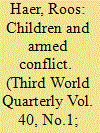

|
|
|
|
|
| Summary/Abstract |
Children are currently being recruited to an increasing extent by armed groups, assuming both ancillary and combat roles. Academic research on this phenomenon has grown in scope over the last few years. However, the current research lacks a comparative perspective. As a result, we presently have a very restricted perspective of the state of the art on the subject of child soldiering, making it difficult to recognise research areas that urgently require further investigation. The ambition of this article is twofold: first, to explore the existing state of child soldier studies across disciplines, and second, to encourage potential research by highlighting three relatively underdeveloped research areas.
|
|
|
|
|
|
|
|
|
|
|
|
|
|
|
|
| 2 |
ID:
154732
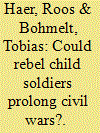

|
|
|
|
|
| Summary/Abstract |
While we know why rebels may recruit children for their cause, our understanding of the consequences of child soldiering by non-state armed groups remains limited. The following research contributes to addressing this by examining how rebels’ child recruitment practice affects the duration of internal armed conflicts. We advance the argument that child soldiering increases the strength of rebel organizations vis-a-vis the government. This, in turn, lowers the capability asymmetry between these non-state actors and the incumbent, allowing the former to sustain dispute. Ultimately, the duration of armed conflicts is likely to be prolonged. We analyse this relationship with quantitative data on child soldier recruitment by rebel groups in the post-1989 period. The results confirm our main hypothesis: disputes are substantially longer when rebels recruit children. This work has important implications for the study of armed conflicts, conflict duration and our understanding of child soldiering.
|
|
|
|
|
|
|
|
|
|
|
|
|
|
|
|
| 3 |
ID:
106058
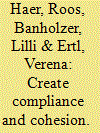

|
|
|
|
|
| Publication |
2011.
|
| Summary/Abstract |
Established conflict theories focus on the role of incentives in the decision to join, stay, or leave an insurgency. These theories, however, disregard the pressure that an organization can impose on its members. Similar to legal organizations, we assert that a rebel organization can sustain itself by effective human resource management. Using narratives resulting from psychological trauma therapy of former combatants of the Lord's Resistance Army (LRA), these management strategies are examined. The analysis shows that the LRA sustains itself in the first place by the use of brute force. However, they also manage themselves by a careful selection process of their fighters, by the conscious creation of social control, and by offering their members an alternative social network in which promotion and compensation play a role.
|
|
|
|
|
|
|
|
|
|
|
|
|
|
|
|
| 4 |
ID:
184190
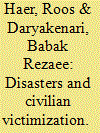

|
|
|
|
|
| Summary/Abstract |
How do natural disasters affect the treatment of civilians by non-state actors? On the one hand, conflict literature argues that adverse shocks influence the strategic interplay between rebel groups and the government, potentially increasing the level of violence against civilians. On the other hand, sociological research on natural disasters argues that they increase social integration and cooperation and are thus expected to reduce the risk of violent behaviour. In this study, we contend that the dynamics of violence against civilians are different in the short term and long term after a disaster strikes. We argue that natural disasters lead to a decrease in violence against civilians perpetrated by rebel groups in the short run. However, over time this temporary improvement in social integration starts to decline, increasing the level of civilian victimization. To examine this potential temporal dynamic, we combine georeferenced information on one-sided violence (Armed Conflict Location & Event Data; ACLED) and data on disasters (Emergency Event Database; EM-DAT). Our results confirm the expected dynamic effects. This research has important implications for our understanding of how disasters can influence the relationship between civilians, rebel groups, and governments.
|
|
|
|
|
|
|
|
|
|
|
|
|
|
|
|
| 5 |
ID:
138781
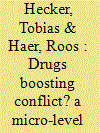

|
|
|
|
|
| Summary/Abstract |
Many studies have emphasized the role of natural resources in the onset and duration of armed conflict. Due to its characteristics, narcotics are considered to be one of the most influential resources. However, the dynamics of how this particular commodity is linked to conflict is still not well understood. Most scholars have focused on the revenue aspects of narcotics and only a few have mentioned the micro-level aspect, i.e., the effect of drug intake and alcohol consumption on combatants' behavior during conflict. With the help of a dataset based on 224 interviews held with former combatants in the Democratic Republic of the Congo, we examined this latter dynamic. Our analyses show, after controlling for armed group-level and individual-level variables, that drug intake and alcohol consumption boost the number of violent actions perpetrated by combatants.
|
|
|
|
|
|
|
|
|
|
|
|
|
|
|
|
| 6 |
ID:
151506


|
|
|
|
|
| Summary/Abstract |
An increasing number of children are actively participating in armed groups, drawing attention to the issue of child soldiering from both international humanitarian organisations and the academic community. Despite this interest, there is a lack of explicit attempts to bring the insights of these two arenas together. More specifically the theoretical issues raised by the scholarly community have not been incorporated into disarmament, demobilisation, and reintegration (DDR) practices. This article combines these two arenas to show that questions related to age, gender, agency and the recruitment of child soldiers in particular have not yet been resolved, leading to problems in the implementation of child-centred DDR programmes.
|
|
|
|
|
|
|
|
|
|
|
|
|
|
|
|
| 7 |
ID:
103679
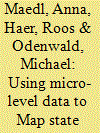

|
|
|
|
|
| Publication |
2011.
|
| Summary/Abstract |
In the study of state failure, scholars and practitioners have mostly focused on macro-level indicators to determine which state is failed and which is not. This focus overlooks crucial local and regional variation that has to be taken into account when designing interventions. In this article, we develop a new approach to examine state failure on this microlevel. Using a unique data-set on Somalia, we identify micro-level indicators for state failure. The analysis shows that micro-level data are crucial for detecting variation in state failure.
|
|
|
|
|
|
|
|
|
|
|
|
|
|
|
|
| 8 |
ID:
190883
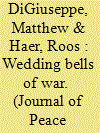

|
|
|
|
|
| Summary/Abstract |
Child marriage is a fundamental violation of human rights. It hinders progress towards development and public health goals. In this study, we argue that armed conflict plays an important role in the occurrence of child marriages; it influences the supply of and demand for young brides. We argue that in conflict settings, families are more willing to marry off their young daughters for protection. Armed conflict can also influence the demand: marriage in general declines due to an imbalance in sex ratio. However, in cases where belligerents use war tactics specifically focused on harming girls, such as sexual violence and girl recruitment, early marriage might increase as the result of armed conflict. To empirically examine these linkages, we combine the Demographic and Health Surveys of West Africa with information on the location of armed conflict. Our study shows that armed conflict generally reduces the occurrence of child marriage with 13% to 18%. However, we observe that when conflict actors use war tactics that specifically harm young girls there is a significant increase of 12% to 18% in the probability of a girl getting married before the age of 18. This research has important implications for our understanding of the relationship between armed conflict, gender inequality, and their impact on children.
|
|
|
|
|
|
|
|
|
|
|
|
|
|
|
|
|
|
|
|
|